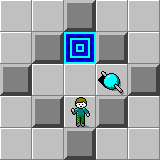Please create an account or Login! Have fun!
Random element: Difference between revisions
(restructured; added and corrected info) |
m (reordered sections (based on https://en.wikipedia.org/wiki/Wikipedia:Manual_of_Style/Layout)) |
||
| Line 21: | Line 21: | ||
The only tile that has random behavior is the random [[force floor]]. In MS, it behaves like a normal force floor, except that it points in a random direction each time an object slides on it and that it is an acting wall to monsters. In Lynx, it is not an acting wall to monsters, but it is also not random at all, instead cycling through the four directions clockwise, beginning with east. All random force floors in the ''entire current session''—not just the current attempt—follow this sequence. The random force floor in Steam acts the same way as in Lynx, except the initial direction is north. | The only tile that has random behavior is the random [[force floor]]. In MS, it behaves like a normal force floor, except that it points in a random direction each time an object slides on it and that it is an acting wall to monsters. In Lynx, it is not an acting wall to monsters, but it is also not random at all, instead cycling through the four directions clockwise, beginning with east. All random force floors in the ''entire current session''—not just the current attempt—follow this sequence. The random force floor in Steam acts the same way as in Lynx, except the initial direction is north. | ||
== See also == | |||
* [[Derandomization]] | |||
== Notes == | == Notes == | ||
<references group=note/> | <references group=note/> | ||
[[Category:Terminology]] | [[Category:Terminology]] | ||
[[Category:Tile groups]] | [[Category:Tile groups]] | ||
Latest revision as of 21:44, 3 May 2021
A random element is any tile in Chip's Challenge whose behavior is determined randomly. Random elements often make it very challenging to achieve the bold time on levels that contain them: the bold on Catacombs has a mere 9/4096 or 1/455.11 chance of being scored, 26 on Mads' Rush II is a mere 1/512 shot, and Lot of Danger's Melinda time is a 1/2096 chance.
Monsters[edit]
There are two monsters that move randomly: blobs randomly choose an adjacent space to move onto and walkers randomly choose a new direction each time they collide with an acting wall.
Ruleset differences[edit]
In Lynx and Steam, the sequence of directional changes for walkers to attempt is determined before the level begins, is shared among all walkers in a level, and never changes between level attempts. In other words, walkers have a fixed random seed, whereas blobs do not. In MS, neither monster has a fixed random seed.
In Lynx and Steam, blobs and walkers do not check which directions are legal before randomly picking one to move in. In particular, walkers can choose forward again after running into a wall, even when the other 3 directions are open. In MS, monsters can never choose a blocked direction when an open direction exists. As a result, some solutions changed from Lynx to MS: the Spirals corruption is one of the most famous.
Here is an example to demonstrate the latter difference:
To solve this level using Lynx or Steam rules, Chip must move 2U on any turn the walker moves away from [2, 2] to reach the exit, assuming that the walker tries (and fails) to move into a wall. The odds of solving this level with perfect timing but without knowing the walker's exact pattern are (3/4)^2 = 9/16,[note 1] as the walker needs to stall for at least 2 ticks for Chip to pass.
Random force floor[edit]
The only tile that has random behavior is the random force floor. In MS, it behaves like a normal force floor, except that it points in a random direction each time an object slides on it and that it is an acting wall to monsters. In Lynx, it is not an acting wall to monsters, but it is also not random at all, instead cycling through the four directions clockwise, beginning with east. All random force floors in the entire current session—not just the current attempt—follow this sequence. The random force floor in Steam acts the same way as in Lynx, except the initial direction is north.
See also[edit]
Notes[edit]
- ↑ Monsters attempt to move on every tick when not mid-move, unlike MS, in which they only attempt movement on the first half of a move.
